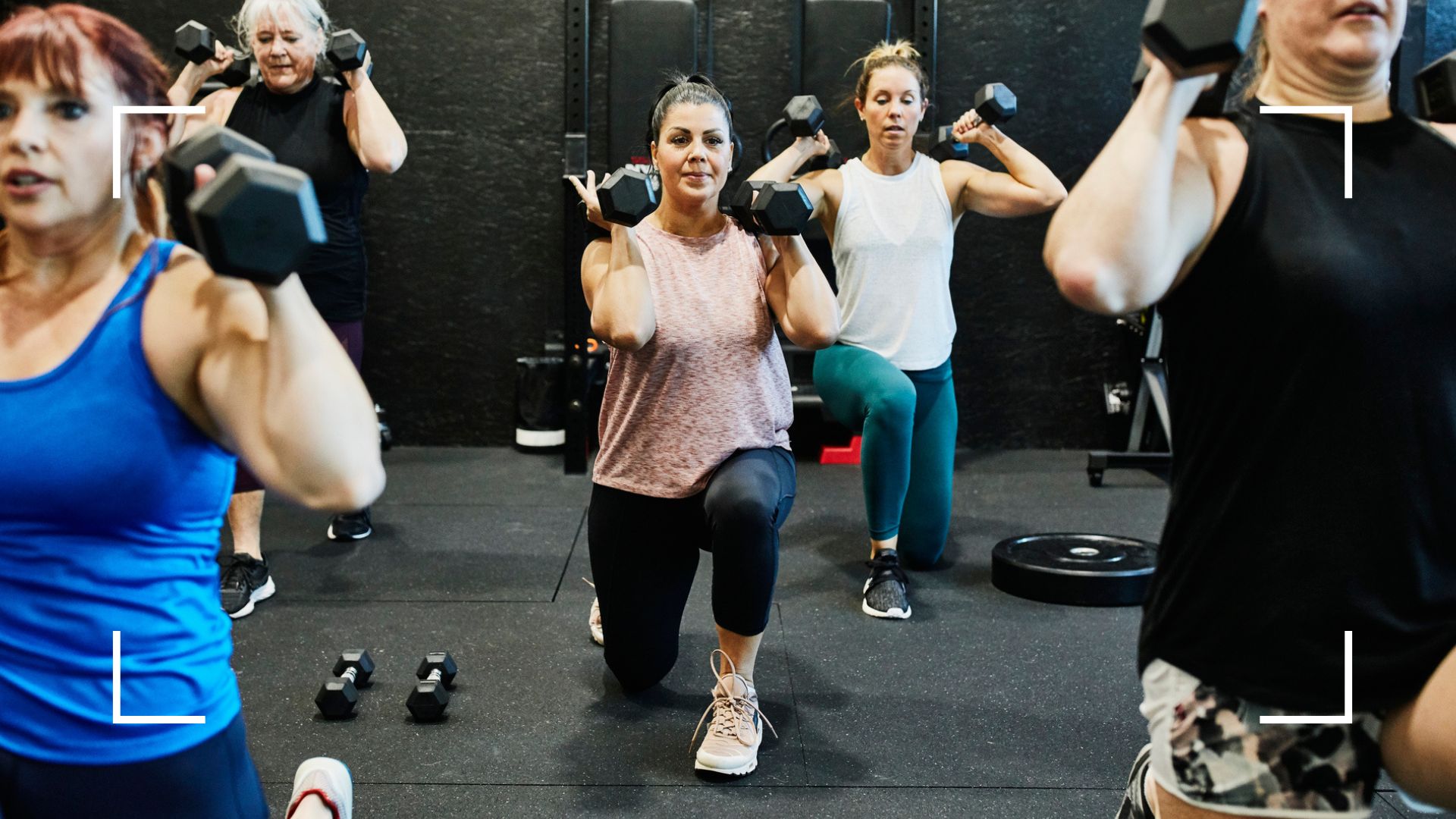How to start strength training for weight loss as a beginner
Three coaches reveal the practical steps to start strength training for weight loss, how many times a week to train, and other useful tips


Strength training for weight loss is one of the more undervalued exercise programs around. While many people immediately turn to cardio when they want to lose weight, this type of exercise can help you to burn calories and build muscle at the same time, no matter your starting ability or fitness level.
Strength training, also known as weightlifting or resistance training, is working out to improve your strength and endurance. Lifting weights - such as dumbbells, kettlebells, and barbells - is a common part of the exercise but it can also include bodyweight exercises and smaller accessories, such as resistance bands.
There are so many benefits of strength training for women outside of weight loss. From reducing the risk of conditions like osteoporosis and muscle loss during menopause to boosting your morning levels of serotonin, it's one of the best workouts around. But for those looking to lose weight without dieting, it can also be very beneficial, as these three strength and conditioning coaches explain.
Is strength training good for weight loss?
Absolutely, the experts say. "Strength training is the most effective way to invest in your strength, along with helping to uplift your energy levels and speed up your metabolism, helping you burn calories faster," says Rachael Sacerdoti, certified personal trainer and strength coach. "Lifting weights and performing bodyweight exercises helps to build lean muscle mass. This is highly beneficial for weight loss since muscle tissue burns more calories than fat, even at rest. Additionally, strength training improves body composition, enhances balance, increases bone density, and helps mobility and range of motion."
You also continue to burn calories long after you put the weights down, says personal trainer and nutrition coach Arabella Featherstone, as your body works to replenish the reserves it used up during the session. It's a process known as post-exercise oxygen consumption, research by the University of South Australia reveals, or more commonly as 'afterburn'. "[Cardio exercise] is effective for immediate calorie burning but once the session ends, the calorie-burning effects subside relatively quickly, unlike after strength training," she explains.
All of this will be beneficial when it comes to getting into a calorie deficit, where you burn more calories than you eat every day, and losing weight healthily and sustainably, where you'll still be seeing results some years down the line.
Of course, you'll need to pair your new-found exercise routine with changes to your diet to continue to see results, warns Amanda Place, certified personal trainer and strength specialist. "Pair your strength training program with a balanced and healthy diet that supports your weight loss goals and provides your body with the necessary nutrients for muscle recovery and growth."
Sign up for the woman&home newsletter
Sign up to our free daily email for the latest royal and entertainment news, interesting opinion, expert advice on styling and beauty trends, and no-nonsense guides to the health and wellness questions you want answered.

Many apps offer programs for strength training you can do at home.
How to start strength training for weight loss
1. Focus on compound lifts
When it comes to strength training for weight loss as a beginner, it's important to start with the basics - and that means compound lifts. These are movements that involve multiple muscle groups and joints working together in a coordinated movement, explains Place, who is also the founder of Sculpt. "Examples include squats, deadlifts, bench presses, and overhead presses," she explains. "These exercises recruit more muscle fibres and burn more calories compared to isolation exercises that focus on single muscle groups."
Compound exercises are particularly important for those who want to lose weight with strength training, rather than just improve their strength and build muscle because they engage more muscle mass during each repetition (individual movement). "This leads to higher energy expenditure and increased post-workout calorie burn. They also trigger the release of growth hormones, which further support muscle development and fat loss," she says.
However, out of all the different movements in strength training, compound lifts can be the trickiest. "Ensure you use proper form and technique with these to prevent injuries and get the most out of your workout," Place warns. One of the best ways to do this is to enlist the help of a personal trainer at your local gym who can give you a program to start with and help you get the best form possible. You can also check out one of the best workout apps since these sometimes have personal trainers available remotely via video call.
2. Remember progressive overload
To see continuous progress, it's important to gradually increase the intensity of your workouts, otherwise known as progressive overload, Featherstone says. "This involves consistently challenging your muscles by either increasing the weight or the sets over time," she explains. "Three to five sets is a general guide for building muscle. As well as building muscle, this ensures your body keeps adapting to the demands of training so you can continue to progress."
For example, you may start strength training for weight loss by doing squats of the barbell (which normally weighs around 20kg), three sets of six repetitions. To make sure you're progressively overloading and improving, over the weeks, you should either:
- Increase the number of repetitions you do during the exercise (e.g. increase repetitions from 6 to 8 and then 8 to 10)
- Increase the weight (e.g. add one 1.25kg or 2.5kg weight plates onto either side of the barbell and continue to squat three sets of six repetitions)
- Increase the number of sets (e.g. do four sets of six repetitions instead of three sets)
- Increase the time spent under tension (e.g. keep the sets, repetitions, and weight the same. However, at the bottom of your squat, pause for three to five seconds)
"[Doing this] not only helps in building muscle, but it also contributes to increased calorie expenditure during and after your workouts," adds Place. "As you gain more muscle mass, your resting metabolic rate increases, supporting your weight loss efforts."
You can increase your load with simple changes in daily life as well - such as a weighted vest for walking. These have normally between 5kg and 10kg in removable weighted bags and they offer extra resistance while you're going about your normal routine. No workout needed.
3. Include some HIIT workouts in your strength training
While afterburn is a significant benefit of strength training over cardio exercise, it doesn't mean that cardio isn't a useful exercise. It can be especially useful for weight loss when done in combination with resistance training in a high-interval training workout (HIIT).
"This type of training involves alternating periods of intense effort with brief rest or active recovery periods," Place says. You can do it in the gym on a treadmill in combination with your weight training or head to a studio to do a beginners' group workout class, such as circuit training.
Either way, she explains, "incorporating elements of HIIT into a strength training program can elevate your heart rate and add a cardiovascular component to your workout. In turn, it also can help boost calorie burn during and after the workout."
4. Increase the amount of protein you eat
As noted, to make the most of strength training for weight loss, you'll need to make some changes to your daily eating style. Strength training puts a lot of pressure on the individual muscles in your body, naturally creating small tears in the fibres that then go through a process of growth and repair. It's during this process that you build muscle, and along with the physical exertion in the gym, burn the most calories.
However, this process requires a few more of the muscles' essential building blocks: protein. "Vital for everybody of every age, high-quality protein is an essential part of a healthy diet helping to build and repair cells, bones, muscles, and joints. An increase in your daily protein, at least 90g, is imperative if you want to stay fit and strong," says Sacerdoti.
You can achieve this level of protein (between 1.6 and 2.2g of protein per kilogram of body weight) by incorporating more of the best high-protein and low-calorie foods into your diet or supplementing what you already eat in your calorie deficit with high-protein snacks, such as a protein shake for weight loss or one of the best protein powders for women.
"You also want to make sure you’re eating a good balance of fats and carbohydrates to give you enough energy to make the most out of your strength training sessions," adds Featherstone.

5. Rest and recovery
Finally, as much as it's important to hit the gym when taking on a strength training for weight loss program, it's equally important to prioritize rest. Without enough rest and recovery time, your body is unlikely to be able to keep up with your progress and you could end up overtraining.
"Allow your muscles sufficient time to recover between strength training sessions to avoid overtraining and support muscle growth," warns PT Amanda Place.
Is 3 days of strength training enough to lose weight?
Three days of strength training, combined with four days of essential rest, will be more than enough to see progress. "Consistency is king," says Sacerdoti. "Resistance at least three times a week will see your strength increase quickly enough that you will begin to fully appreciate the benefits of lifting weights. It will also provide better fat-burning capabilities as the body burns more fat to repair and rebuild the muscles."
These three days don't have to be exclusively lifting weights in the gym though. For example, you could try Pilates for strength training, a combination of cardio and weights in a spinning for weight loss workout, or a bodyweight session at home.
When it comes to exercise for weight loss, the most important thing is that you enjoy what you're doing. Even if it's only three sessions a week, you're so much more likely to continue the program (and so actually burn the calories and build the muscle) if you enjoy the process. If you find that it doesn't quite work for you - try something else, such as cycling as a workout or doing yoga every day.
How long does it take to see weight loss with strength training?
You should start to see results within about a month or two, says Featherstone. "To see results, you should give it a few weeks of consistency to start noticing small changes. You might find clothes are fitting better, however, these changes won’t be drastic yet."
She says, "You want to give it at least 8 weeks to really start seeing muscle development in a noticeable way. As you progress over the two-month mark, provided you’ve been consistent and followed a well-structured program, you can expect more noticeable changes."

Grace Walsh is woman&home's Health Channel Editor, working across the areas of fitness, nutrition, sleep, mental health, relationships, and sex. She is also a qualified fitness instructor. In 2025, she will be taking on her third marathon in Brighton, completing her first ultra marathon, and qualifying as a certified personal trainer and nutrition coach.
A digital journalist with over seven years experience as a writer and editor for UK publications, Grace has covered (almost) everything in the world of health and wellbeing with bylines in Cosmopolitan, Red, The i Paper, GoodtoKnow, and more.
-
 Celebrities you never knew got their start as models, from Angelina Jolie's 'terrible' experience to A-listers who started as pageant queens
Celebrities you never knew got their start as models, from Angelina Jolie's 'terrible' experience to A-listers who started as pageant queensWhether it was just for a short time or it's how they got discovered for something else, these stars owe it all to striking a pose
By Jack Slater Published
-
 Smeg's retro hand mixer puts the 'king' in baking - I'm convinced it's the best
Smeg's retro hand mixer puts the 'king' in baking - I'm convinced it's the bestThe Smeg 50s Style Hand Mixer is every keen baker's dream: it whips up cream, mixes cookie dough, and kneads bread like the best hand mixers on the market
By Laura Honey Published